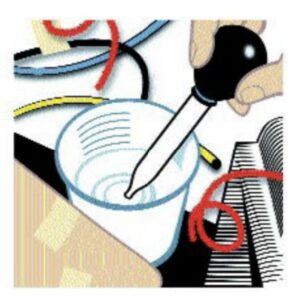Overview
Materials
Per Team:
|
For the Testing Activity:
|
Instructions
BEFORE CLASS:
- Determine how much time you will allow teams for design and construction.
- If you decide to hold this activity as a contest, prepare to keep score.
- Place students in teams and distribute materials.
- Explain the challenge: design and build a device to safely drop a cup of water, retaining as much water in the cup as possible.
- List the constraints:
- The device, or part of it, can be below or above the cup. The cup must be part of the device and hold 0.68 fl. oz. (20 mL) of water during the drop.
- The device, including the cup, can be no longer than 2 feet tall from top to bottom.
- Only water is to be used in the cup.
- The cup can be modified but must hold 20 mL of water or the team will be disqualified.
- Tell students how much time they have for design and construction. Explain that they are allowed to sketch their designs, and tell them when they may begin.
- Set up a ladder and mark the ladder with masking tape at 7 feet and 9 feet (2.13m and 2.74m). Place waterproof covering and/or towels for the floor beneath the ladder.
- Assign an adult to be the “Tester” who can stand on the ladder (using appropriate ladder safety), and assign someone to be the “Water Judge.”
- Prepare water with food coloring if desired (adding food coloring makes spilled water easier to see), and prepare syringe for filling devices.
- When time is up for design and construction, explain that each team has only one attempt at releasing their device.
- Station the Tester on the ladder.
- Each team has one student team member (the “Holder”) who holds the device until the drop.
 The Holder takes the device to the Water Judge, who fills the cup with 20mL of water. The Judge leaves the device on the table for the Holder to pick up.
The Holder takes the device to the Water Judge, who fills the cup with 20mL of water. The Judge leaves the device on the table for the Holder to pick up.- When it is the team’s turn, the Holder passes the team’s device to the Tester on the ladder.
- The Tester releases the device from between the set heights of 7 and 9 feet (2.13m and 2.74m), according to the following guidelines:
- The Water Judge okays the height before the Tester can release the device.
- The whole device must be between 7 and 9 feet above the floor before the drop.
- With one hand on the ladder, the Tester must drop—not toss, lower, or push—the device.
- No part of the device can connect to any freestanding objects such as the ladder or the Tester after release.
- After the device lands, the Tester takes it to the Water Judge, who records the amount of water left in the cup, using the syringe. The judge rounds up to the closest mL.
- Dry the target after each drop.
DESIGN & CONSTRUCTION PHASE
TESTING PHASE SETUP:
TESTING PHASE:
Guiding questions
-
How can you keep the cup upright when it is dropped from a 7–9 ft. height?
-
How heavy is 20mL of water? How fast will it fall? Is there a way to slow down its drop?
-
If the cup tips, what will prevent the water from spilling out?
Engineering & science connections
- Engineers solve problems under constraints, working with the materials, budget, and time available to them. In this activity, you were constrained by the materials available to build your device and the time you had to design your device before testing began.
- In this activity, gravity (a force acting downward) creates potential energy for the cup held at the top of the ladder, and is converted to kinetic energy (motion) as it drops.
- In engineering terms, the challenge was to find a way to reduce the sudden conversion of kinetic energy during the collision with the floor.
This activity is provided by Fluor Corporation. Each year for Engineers Week Fluor offices compete in friendly contests. This activity is adapted from these events.


0 Comments